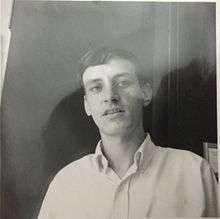Alwyn Howard Gentry
| Alwyn Howard Gentry | |
|---|---|
| Born |
January 6, 1945 Clay Center, Kansas |
| Died | August 3, 1993 (aged 48) |
| Citizenship | United States |
| Nationality | United States |
| Fields | Botany |
| Alma mater |
Kansas State University (BA, BS) University of Wisconsin–Madison (MS) Washington University in St. Louis (Ph.D.) |
| Thesis | An Eco-evolutionary Study of the Bignoniaceae of South Central America (1972) |
| Known for |
Flora of tropical forests; Gentry Forest Transect |
| Author abbrev. (botany) | A.H.Gentry |
Alwyn Howard Gentry (6 January 1945 – 3 August 1993) was an American botanist and plant collector, who made major contributions to the understanding of the vegetation of tropical forests.

Education
Gentry was born on 6 January 1945 in Clay Center, Kansas, and received his schooling at the Clay Center Community High School, from which he graduated in 1963. He graduated from Kansas State University in 1967 with a B.A. in physical science and a B.S. in botany and zoology. He earned his master's degree in 1969 at the University of Wisconsin–Madison as a student of botanist Hugh Iltis, with a thesis on the genus Tabebuia (Bignoniaceae) of Central America, a subject which he continued to study at Washington University in St. Louis, Missouri, from which he received his doctorate in 1972, with a Ph.D. thesis entitled An Eco-evolutionary Study of the Bignoniaceae of South Central America.[1]
Career
Gentry spent his entire working career at the Missouri Botanical Garden, starting as an assistant curator in October 1972. In 1974, he made his first visit to Peru, a country that became the major focus of much of his subsequent work; he made his second trip there in 1976 and by the time of his death had visited the country 33 times. He also maintained his interest in the Bignoniaceae: he contributed treatments of the family to nine volumes, including the Flora of Panama, and had a further five in press when he died.
One of Gentry's major innovations was the use of transect samples as a tool for assessing the composition and structure of tropical forests, known as the Gentry Forest Transect. His method, allied to his encyclopedic knowledge of tropical plants, allowed him to sample a site in a matter of days, and over the course of his career he amassed data from over 200 such transects worldwide.
Alwyn Gentry was prolific both as an author and as a plant collector: he published over 200 works and had many more on hand at the time of his death; and he collected over 80,000 plant specimens, hundreds of which have proved to be species new to science. Because many of the plants that he encountered during his transect sampling were not flowering, Gentry developed the ability to identify species from vegetative specimens, not just from flowers and fruits, an ability that led to the publication of his Field Guide to the Families and Genera of Woody Plants of Northwest South America,[2] completed just months before his death.
In 1990, Conservation International established a Rapid Assessment Program (RAP) to undertake quick assessments of areas deemed to be significant for conservation. Gentry's transect method was well suited to such work and he became increasingly involved as a member of the RAP team.
Death
On 3 August 1993, Alwyn Gentry was on a RAP mission in western Ecuador, when the light aircraft in which he was travelling crashed into a mountain ridge near Guayaquil. Four people—the pilot, Gentry, American ornithologist Theodore A. Parker III, and Ecuadorian ecologist Eduardo Aspiazu—died in the crash; three other researchers survived. Parker and Gentry are memorialized in the annual Parker/Gentry Award for Conservation Biology of the Field Museum of Natural History.[3]
Several plant species have been named after Gentry, including: Acidocroton gentryi, Citharexylum gentryi, Crossothamnus gentryi, Eleutherodactylus gentryi, Hedyosmum gentryi, Metalepis gentryi, Palicourea gentryi, Phyllanthus gentryi, Sobralia gentryi and Zamia gentryi, as well as a bird, Herpsilochmus gentryi. In several instances, Gentry had been involved in the collection of the type specimens of these plants.[4][5][6]
References
- ↑ Miller, James S; Barkley, Theodore M; Iltis, Hugh H; Lewis, Walter H; Forero, Enrique; Plotkin, Mark; Phillips, Oliver; Rueda, Ricardo; Raven, Peter H (1996). "Alwyn Howard Gentry, 1945-1993: A Tribute". Annals of the Missouri Botanical Garden. 83 (4): 433–60. JSTOR 2399988.
- ↑ Gonzalez, Favio (1997). "Reviewed Work: A Field Guide to the Families of Woody Plants of Northwest South America by A. H. Gentry". Journal of the Torrey Botanical Society. 124 (1): 98–100. JSTOR 2996602. doi:10.2307/2996602.
- ↑ "Parker/Gentry Award for Conservation Biology". The Field Museum. 2007. Retrieved 27 October 2010.
- ↑ Whitelock, Loran M (2002). The Cycads. Portland, OR: Timber Press. pp. 304–5. ISBN 0-88192-522-5.
- ↑ Téllez-Valdés, Oswaldo (1996). "Two new species of Dioscorea (Dioscoreaceae) from Peru". Brittonia. New York Botanical Garden. 48 (1): 100–103. doi:10.2307/2807670.
- ↑ D'Arcy, W G; Ronald L Liesner (1981). "Hedyosmum (Chloranthaceae) in Panama". Systematic Botany. American Society of Plant Taxonomists. 6 (1): 74–86. JSTOR 2418637. doi:10.2307/2418637.
- ↑ IPNI. A.H.Gentry.